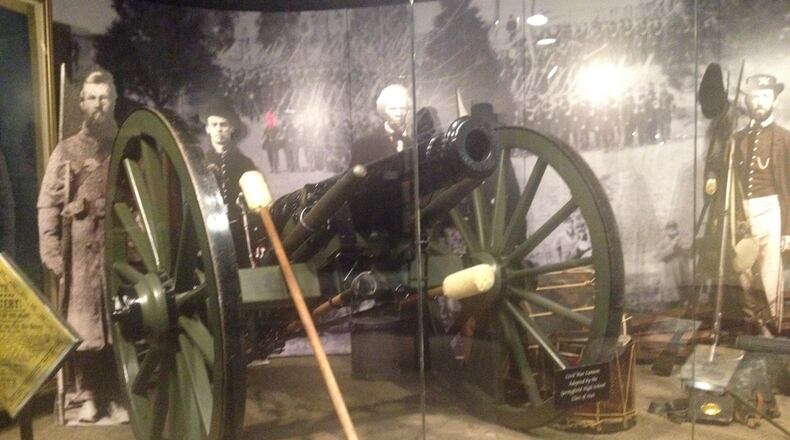The Heritage Center requires community support to maintain the historic building, considered by officials to be its most important artifact. Constructed in 1890, the Richardsonian Romanesque structure with its iconic clock tower, served as Springfield’s City Hall and marketplace.
Now the facility is home to the numerous exhibit galleries and storage for a wide-ranging collection of antiques, farm tools, documents and relics, military items, a locally-made Russell steam engine, and four International Harvester vehicles. All cover the history of Clark County from early Paleo Native Americans to modern day.
Military artifacts include a tent used in the Civil War, uniforms, pistols, muskets, bayonets, rifles, a Civil War cannon and a World War I canister that contained the Armistice document that ended the conflict.
A Civil War tent is a rare artifact that can’t be found in many museums. It belonged to Ralph and William Hunt, who grew up on the Hunt Farm (former Simon Kenton Homestead). Ralph was captured at Bull Run in September 1861 and later released. He returned to duty and was joined by his brother. After the war they returned home and stored the tent in the homestead attic, where it was discovered decades later in impeccable condition.
The cannon was captured by the 44th Ohio Volunteer Infantry from the Confederate Army during the Battle of Lewisburg on May 23, 1862. The cannon originally was stolen by the Confederates from the U.S. Arsenal in Virginia at the start of the war.
In 1836, more than 600 Conestoga wagons came to Clark County with many of the pioneer families settling here. Twenty-six years before this massive influx, in 1810, a Conestago wagon carrying David Crabill and his family found its way here and that covered wagon is on proud display at the Center.
Other vehicles on exhibit include three International Harvester trucks and a Travelall from 1973, the last year of its production. The Traveall, recognized as a forerunner to the current SUVs, has a 4-speed manual transmission with a 2-speed case and all-wheel drive.
Photographs of many of these items are featured weekly on the pages of the Springfield News-Sun as part of its commitment to remind us of our rich heritage. They provide a pictorial taste of how Clark County has evolved since the days of its early settlers.
To get a closer view, a visit to the Heritage Center brings you within touching distance of these one-of-a-kind treasures. Volunteers are available to provide tours for individuals and groups. Heritage Center volunteers donated 4,352 hours of their time in 2021, which helped the Heritage Center maintain a regular weekly schedule during the COVID outbreak.
Stewards of this grand local landmark take pride in collecting, protecting, preserving, interpreting and sharing the treasures with us.
We, in turn, should follow the example of the volunteers and support the Heritage Center. It is the best bargain in Clark County - free to all residents.
Dave Hobson is a retired U.S. Congressman from the 7th District; Jo Blondin is president of Clark State College.



